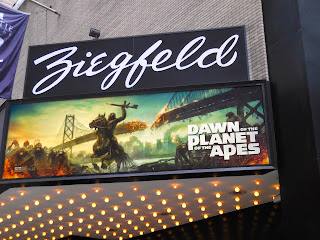Ziegfeld Museum
Last week we heard the news that the great Ziegfeld movie theater might be closing. It's been here since 1969, and it's one of the last remaining single-screen palaces in the city.
*UPDATE January 2016: Confirmed. The theater is closing to become a high-end corporate event space.

I like it because it's big, truly big, with those red velvet chairs you don't find anymore in this day of stadium seating.
I also like it because it's unusual.

The entire entryway, from the downstairs lobby up to the theater lobby, contains Reade's Ziegfeld Museum, made up mostly of statuary and a series of vitrines displaying artifacts from the old days of the Ziegfeld Follies.

A costume once belonging to "Ziegfeld diva" Lillian Lorraine is on display, accompanied by a sign that reads, in 1920s font, "These too were part of the Ziegfeld mystique."
In Scandals and Follies, author Lee Davis wrote that Florenz Ziegfeld "was insanely in love with Lillian Lorraine and would remain so, to one degree or another, for the rest of his life, despite her erratic, irresponsible, often senseless behavior."

Another display is dedicated to Marilyn Miller, who began in vaudeville in childhood, debuting as "Mademoiselle Sugarlump." After a stellar career on the Follies stage, she died from complications from nasal surgery and was buried in Woodlawn Cemetery.
Fun fact from Wikipedia: "A sculpture of Miller, in the title role of Sunny, can still be seen atop the former I. Miller Shoe Company Building" at 46th and Broadway in Times Square.

The museum also includes a very 1960s-looking bust of "Funny Girl" Fanny Brice, and a statue of an elephant.
Even the wood paneling on the walls comes with a story. "STORY OF THIS WOOD," reads the faded plaque screwed to the wall:
"Carbon 14-isotope dating shows this wood has been buried in a peat bog near Cambridge, England, since 2120 B.C." Thanks to rising sea levels and the pressures of 4,100 years, the wood has a rich, charcoal hue. "None has proven to be as large or well preserved as this one."

The same could be said for the Ziegfeld. It's large and well preserved, and it's old. It's got a story to tell--and it should be allowed to keep telling it.
*UPDATE January 2016: Confirmed. The theater is closing to become a high-end corporate event space.

I like it because it's big, truly big, with those red velvet chairs you don't find anymore in this day of stadium seating.
I also like it because it's unusual.

The entire entryway, from the downstairs lobby up to the theater lobby, contains Reade's Ziegfeld Museum, made up mostly of statuary and a series of vitrines displaying artifacts from the old days of the Ziegfeld Follies.

A costume once belonging to "Ziegfeld diva" Lillian Lorraine is on display, accompanied by a sign that reads, in 1920s font, "These too were part of the Ziegfeld mystique."
In Scandals and Follies, author Lee Davis wrote that Florenz Ziegfeld "was insanely in love with Lillian Lorraine and would remain so, to one degree or another, for the rest of his life, despite her erratic, irresponsible, often senseless behavior."

Another display is dedicated to Marilyn Miller, who began in vaudeville in childhood, debuting as "Mademoiselle Sugarlump." After a stellar career on the Follies stage, she died from complications from nasal surgery and was buried in Woodlawn Cemetery.
Fun fact from Wikipedia: "A sculpture of Miller, in the title role of Sunny, can still be seen atop the former I. Miller Shoe Company Building" at 46th and Broadway in Times Square.

The museum also includes a very 1960s-looking bust of "Funny Girl" Fanny Brice, and a statue of an elephant.
Even the wood paneling on the walls comes with a story. "STORY OF THIS WOOD," reads the faded plaque screwed to the wall:
"Carbon 14-isotope dating shows this wood has been buried in a peat bog near Cambridge, England, since 2120 B.C." Thanks to rising sea levels and the pressures of 4,100 years, the wood has a rich, charcoal hue. "None has proven to be as large or well preserved as this one."

The same could be said for the Ziegfeld. It's large and well preserved, and it's old. It's got a story to tell--and it should be allowed to keep telling it.



Comments
Post a Comment